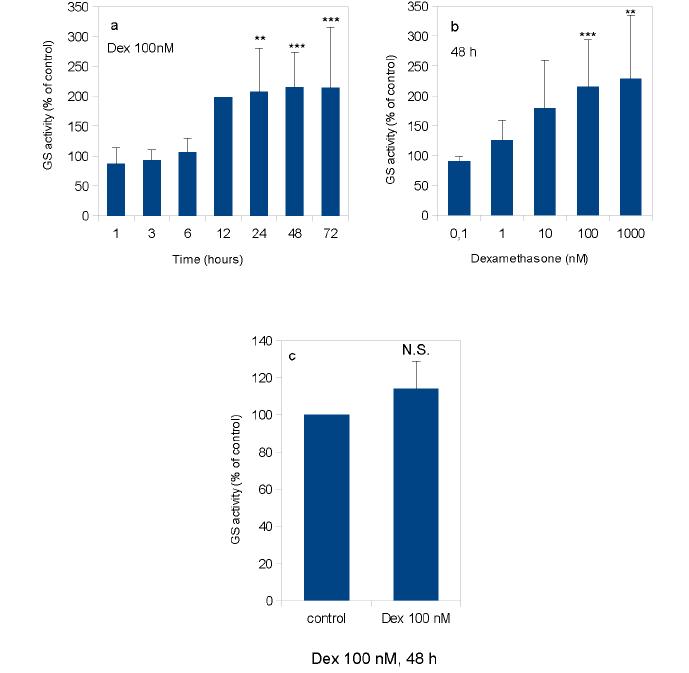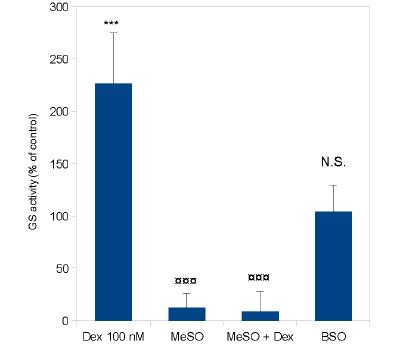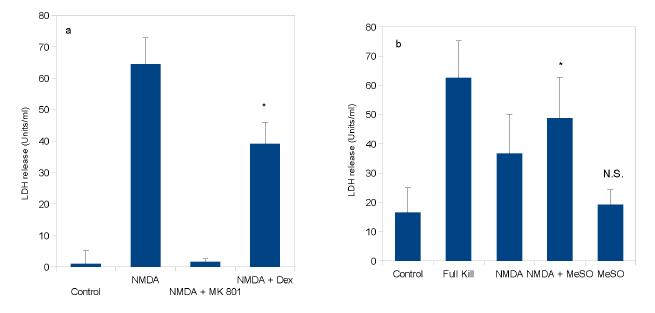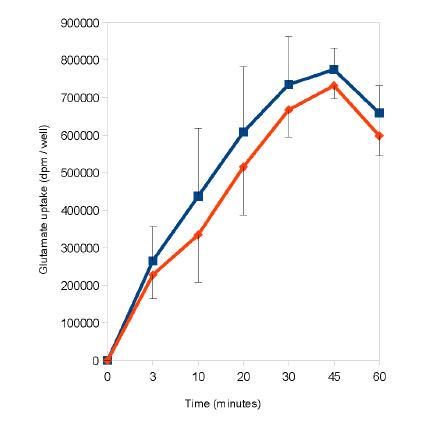1. Introduction
The effects of glucocorticoids on brain cell survival or death remain a matter of controversy since both their neuroprotective and neurotoxic actions were described [1,2,3,4]. Almost thirty years ago, Sapolsky and Pulsinelli [5] demonstrated that a prolonged exposure to glucocorticoids led to hippocampal neuronal loss in male rats. Since then, several groups have determined that glucocorticoids may significantly increase the deleterious action of various stimuli both in vivo and in vitro. These include hypoxia-ischemia-induced brain damage [6], excitotoxicity of glutamate receptors agonists [7], neuronal death triggered by reactive oxygen species [8,9], as well as neurotoxicity induced by β amyloid or gp 120 [10,11]. More recent experiments have also shown that acute neonatal exposure to glucocorticoids induced a rapid and selective apoptosis of the cerebellar neural progenitor cells in rats and led to long term motor and cognitive impairments [12].
Conversely, Sloviter and coworkers [13] demonstrated a long time ago that ablation of the adrenal glands induced a selective degeneration of granule hippocampal neurons in adult rats. This cellular loss could be prevented by administration of corticosterone, thus suggesting that physiological levels of glucocorticoids are required to sustain neuronal survival. Similar results were obtained by different groups [14,15]. Glucocorticoids have also been known to exert protective actions against glutamate toxicity [16] and ischemia-induced neuronal degeneration [17,18].
The molecular mechanisms underlying the effects of steroids on brain tissues also remain a controversial issue. It is generally accepted that steroids exert their action via an interaction with intracellular receptors. These hormone-receptor complexes then bind to specific sites on DNA chains, behaving as hormone-dependent transcription factors. Two types of adrenal steroid receptors have been described in mammalian brain. Type I receptors, also known as mineralocorticoid receptors, present a high affinity for corticosterone and aldosterone, whereas type II receptors have a higher affinity for dexamethasone and a 10 times lower affinity for corticosterone [19,20,21]. Some experimental evidence suggests that neuroprotection might by preferentially a consequence of mineralocorticoid receptors occupancy [22,23]. Numerous potential targets have been proposed to be controlled by glucocorticoids such as glucose transport and energy supply [24], ionic conductance and membrane properties [25], nitric oxide synthase (iNOS), cycloxygenase, Interleukin1β, lipocortin, heme-oxygenase (HO-2), N-methyl-D-aspartate (NMDA) receptors [26], glutamine synthetase and proteins of the bcl-2 family [27,28,29,30,31,32] Dexamethasone has also been shown more recently to reduce both the extent of brain lesions in rat models of hypoxia/ischemia and the expression of cytokine and factors involved in inflammatory brain damages, such as tumor necrosis factor and chemokine receptor CXCR4 [33,34]. On the other hand, it has also been suggested that glucocorticoids may exert rapid, non genomic actions, through an interaction with membrane receptors [35,36,37]
Glutamate, the predominant excitatory neurotransmitter in the mammalian central nervous system, is released from glutamatergic neuronal vesicles through a calcium-dependent mechanism. Its postsynaptic effect on a bundle of different glutamate receptors is halted by a rapid uptake of extracellular glutamate via the action of a family of excitatory amino acid transporters (EAAT), present in the membrane of glial cells. Glutamate is then amidated to form glutamine, a non neuroactive compound, which is in turn released and taken up by neurons to be converted back into glutamate. This so called glutamate-glutamine cycle plays a central role in the control of extracellular glutamate concentrations. Excessive accumulation of glutamate in the synaptic cleft has indeed been involved in the process of neuronal degeneration observed in a variety of acute and chronic brain damage including ischemia and hypoxia, hypoglycemia, trauma as well as neurodegenerative diseases [38,39,40,41,42,43]. Glutamine synthetase (GS) which converts glutamate into glutamine is a key enzyme controlling the intracellular concentration of glutamate and hence the ability of glial cells to clear glutamate from the synaptic cleft [42,44,45,46]. The expression of GS in mammalian systems is regulated principally by an increased transcription and/or a regulation of protein stability [40]. Glucocorticoids have been known for a long time to enhance GS expression in various tissues including primary cultures of mouse astrocytes [47]. In the present paper we have thus studied in cultures of mouse brain cortical cells, the effect of dexamethasone, a potent synthetic glucocorticoid, on glutamine synthetase activity and neuronal sensitivity to NDMA treatment. Our results show that long term treatment by 100 nM dexamethasone significantly enhanced GS activity and protected neurons from NMDA-induced necrosis thus suggesting that neuroprotection was mediated via an enhancement of the astrocytic glutamine synthetase activity.
2. Material and Methods
2.1. Material
Dulbecco's Eagle's minimal essential medium (DMEM), poly-D-lysine, laminin, cytosine β-D-arabinofuranoside (Ara-C), methionine sulfoximineand steroids were obtained from Sigma Chemical Co. (L'Isle D'Abeau, France). Streptavidin coupled to Alexa fluor 488 was purchased from Molecular Probes (Leiden, Netherlands). Horse serum, fetal bovine serum were from Life Technologies (Cergy Pontoise, France). The antibody raised against GR was purchased from Santa Cruz Biotechnology (CA, USA). N-Methyl-D-aspartate (NMDA) was from Tocris (Bristol, U.K.). 3H-glutamate (specific activity 1.86 × 1012 Bq/mmole) was purchased from NEN (Paris, France).
2.2. Cortical cell cultures
Astrocytes cultures were prepared from postnatal Swiss mice (1‒3 days after birth), as described by Rose et al. [48]. Dissociated cortical cells were grown in multiwell dishes in Dulbecco's minimal essential medium (DMEM) containing 25 mmol/L glucose and supplemented with 10% horse serum, 10% fetal bovine serum and 2 mmol/L L-glutamine. Cultures were kept at 37 °C in a humidified 5% CO2-containing atmosphere until they reached confluency (about 10 days in vitro). Confluent cultures were used either as astrocytic cultures or as a support for mixed cultures of neurons and astrocytes.
Mixed cortical cultures containing neurons and astrocytes were prepared from Swiss mice embryos at 14‒16 days’ gestation [48]. Briefly, dissociated cortical cells were plated in 6 well dishes on a previously established layer of confluent astrocytes, using DMEM supplemented with 5% horse serum, 5% fetal bovine serum and 2 mmol/L L-glutamine. After 3 days in vitro (DIV), the division of non-neuronal cells was halted by exposure to 10 µmol/L cytosine-β-D-arabinofuranoside (Ara C). Partial medium replacement was then performed twice a week until 12 DIV, time when the cultures were shifted to serum-free DMEM.
Near pure neuronal cell cultures were established from Swiss mouse embryos [48]. Cells taken from brain neocortex were gently dissociated and plated in multiwell dishes, previously coated with poly-D-lysine and laminin, in DMEM supplemented with 5% fetal bovine, 5% horse serum and 2 mmol/L L-glutamine. After 3 DIV, the division of non-neuronal cells was halted by exposure to 10µmol/L Ara-C. There was no further exchange of the media. Experiments were performed after 13 DIV on cultures containing less than 5% astrocytes (as monitored using GFAP immunoreactivity).
2.3. Determination of excitotoxic cell death
After 10 DIV, half of the culture medium was changed by DMEM supplemented with 10 µmol/L glycine and the cells received 100 nM dexamethasone. After 13 DIV, cultures were gently washed with glycine containing DMEM 2‒3 hours before the addition of NMDA (12.5 µmol/L) and dexamethasone (100 nM). After a further incubation for 24 h at 37 °C, neuronal death was ascertained by examining the cultures under bright field microscopy and quantified by measuring the amount of lactate deshydrogenase (LDH) released from damaged cells into the bathing medium [49]. Background LDH levels were determined in cultures subjected to sham wash and subtracted from experimental values (control experiments). LDH levels corresponding to complete neuronal death (full kill) were determined in sister cultures exposed to a supramaximal, 100 µmol/L, NMDA concentration for 24 hours. The difference between full kill and control levels represents the extent of specific NMDA-induced toxicity.
2.4. Immunocytology
Cultured astrocytes or neurons were fixed by incubation with 4% paraformaldehyde and washed with phosphate buffered saline (PBS). The immunochemical staining was performed by the fluorescence technique. The primary antibody used was a rabbit polyclonal directed against mouse GR (1/100). The corresponding secondary biotinylated antibody (Goat anti-rabbit, 1/1000) was revealed using streptavidin conjugated to fluorescent probe Alexa fluor 488). The negative controls were obtained in parallel incubations carried out in the absence of the primary antibody.
2.5. Determination of glutamine synthetase activity
Experiments were carried out with primary mouse cortical astrocytic or near pure neuronal cultures grown in six-well plates. The activity of GS was assessed by measuring its glutamyl transferase activity using a colorimetric assay adapted from Harmon and Thompson [50]. In brief, cells are collected by a gentle scrapping and centrifuged at 350 × g. The final cell pellet was resuspended in 0.4 mL of water, thawed on ice and submitted to sonication (3 × 10 sec on ice at 20 KHz). 0.2 mL of sonicate was added to 0.1 mL HAS buffer, pH 6.2, containing hydroxylamine hydrochloride and arsenate dibasic, and 0.7 mL substrate containing a trizma-maleate buffer, L-glutamine and MnCl2. Reactions were performed at 40 °C during 30 min and terminated by the addition of 0.75 mL of quench medium containing trichloroacetic acid, HCl and FeCl3∙6H2O. Tubes were vortexed, centrifugated at 8000 × g to remove particulate matter, and assayed for absorbance at 500 nm. The values were expressed per mg cell protein. Protein contents in each sample were quantified by the BCA protein assay reagent kit (Perbio science, France) using bovine serum albumine (BSA) as a standard.
2.6. Determination of glutamate uptake
Astrocytes were incubated for increasing periods of time (3‒60 min) in the presence of 3H-glutamate (3.7 × 103 Bq/well). At the end of the incubation each well was carefully washed three times by ice-cold phosphate buffered saline (PBS), pH 7.4. The radioactivity associated with the cells was then determined by liquid scintillation spectrometry (Packard 2900) after digestion of the cells with 1M sodium hydroxide. Parallel experiments carried out at 4 °C indicate that more than 90% of glutamate uptake is an active process, abolished at low temperature.
2.7. Statistical analysis
Results were expressed as mean values (± s.d.) in at least 3 distinct experiments. Statistical analyses were carried out using the Student-t-test.
3. Results
We first studied the presence and the localization of glucocorticoid receptors (GR) in both types of primary cultures by immunofluorescence. We observed that GR labeling was relatively similar in astrocyte cultures (Figure 1 left panel) and in near pure neuronal cultures (Figure 1 right panel). Although fluorescence intensity appeared variable from one cell to another, most of the cells were GR positive in the two populations with a diffuse subcellular distribution, in the cytoplasm as well as in the nucleus and even in the cell extensions.
We then measured the effect of dexamethasone (Dex) on glutamine synthetase activity in astrocyte cultures. As shown in Figure 2 (panel a), Dex (100 nM) induced a progressive increase in GS activity. This stimulation became significant after 24 h and reached about 250% of control value after 48‒72 h incubation. We also determined the dose-response curve of this steroid effect. As shown in Figure 2 (panel b), the increase in GS activity, measured after 48 h incubation, became apparent, but not significant, at a concentration of 10 nM and reached its maximum at 100 and 1000 nM. None of the other steroids tested, including 17 β-estradiol, testosterone and progesterone, induced any increase in GS activity, even after prolonged incubation (data not shown). We similarly measured the effect of Dex on GS activity in near pure neuronal cultures. We indeed observed a faint GS activity in these cultures but Dex treatment (100 nM, 48h incubation) failed to induce any increase in enzyme activity (Figure 2, panel c).
Since methioninesulfoximine (MeSO) has been described as a relatively specific inhibitor of GS [45,51], we have tested the effect of MeSO (100 µM) on both basal and Dex-stimulated GS activities in astrocyte cultures. As shown in Figure 3, MeSO almost completely inhibited GS activities in both control and Dex-treated cultures. In addition, we have also verified in a parallel experiment that MeSO failed to alter either astrocyte morphology or viability within 72 h incubation (results not shown). The inhibitory effect of MeSO was rather specific since buthionine sulfoximine (BSO), a parent compound, did not affect GS activity in astrocytes (Figure 3). We have now tested the effect of dexamethasone on the toxicity induced by N-Methyl-D-Aspartic Acid (NMDA, a potent synthetic agonist of ionotropic glutamate receptors) in mixed cultures of neurons and astrocytes. As shown in Figure 4a, NMDA (12.5 µM) exerted a very significant toxicity, leading to the death of ~ 60% of the neuronal population, as determined following medium LDH release. This toxicity was almost completely blocked in the presence of Dizolcipine (MK 801, 1 µM) a known inhibitor of these NMDA receptors [18]. The toxic effect of NMDA was significantly reduced in cultures pre-treated for 72 h in the presence of 100 nM Dex.
We also observed that addition of dexamethasone immediately before NMDA treatment failed to protect neurons from drug toxicity (not shown). Conversely, we noted in another series of cultures that NMDA-induced toxicity was significantly enhanced in the presence of MeSO, which by itself failed to induce any significant cell death (Figure 4b). Parallel experiments carried out in near pure neuronal cultures to test a possible effect of dexamethasone on NMDA-induced neuronal death failed to demonstrate any action of Dex pre-treatment (results not shown).
Since glutamate uptake by astrocytes is a key step in the prevention against the toxic action of excess glutamate, and given the known effect of glucocorticoid on amino acid transport in various mammalian tissues including astrocytes [24], we determined the effect of dexamethasone on glutamate uptake in astrocyte cultures. We observed that the tracer was readily taken up by the cells and that incorporation reached a maximum after ~ 40 min (Figure 5). At 4 °C, this uptake only represented 5‒10% of the amount measured at 37 °C, thus indicating that it corresponds to an active transport rather than to adsorption. When comparing both the kinetics and the extent of glutamate uptake in dexamethasone-treated cells to those of control cells, we only noted a slight and insignificant decrease (Figure 5).
4. Discussion
The L-amino acid glutamate is a major excitatory neurotransmitter in the mammalian central nervous system and is involved in a great variety of brain functions including learning, memory, sensori-motricity, brain development and endocrine control of peripheral organs [52]. On the other hand, excess of glutamate has been shown many years ago to be toxic for neurons [49]. A concept called“excitotoxicity” has been proposed by Rothman and Olney [53] who suggest that excessive stimulation of glutamate receptors may induce neuronal death. Since then, numerous authors have described that increased levels of glutamate in synaptic clefts trigger neuronal degeneration in both acute insults (ischemia, brain trauma....) or chronic neurodegenerative diseases (Huntington's disease, Parkinson's disease, Alzheimer's disease or amyotrophic lateral sclerosis) [43,54]. It appears therefore of paramount importance for brain tissues to carefully control the level of glutamate in the extracellular space in order to maintain the phasic character of neurotransmission but also to guarantee neuronal survival.
Glutamate is continuously released in the extracellular fluid and inhibition of cellular glutamate uptake leads within seconds to extracellular glutamate accumulation. Glutamate may be released from nerve terminals by exocytosis of synaptic vesicles but also via other non vesicular mechanism for exemple via the glutamate-cystine exchange (xCT) which carries cystine into the cell in exchange for internal glutamate [43].
On the other hand, a family of high affinity glutamate transporters has been identified in brain tissue. This family of five members (EAAT 1‒5) use the Na+/K+ transmembrane gradient to transport glutamate back into the cells following synaptic release. EAAT1 and EAAT2 were primarily observed in astrocytes whereas EAAT3-5 were mainly expressed in neurons. Numerous experimental results now indicate that astrocytes play a major role by scavenging excess glutamate to prevent neuronal excitotoxic death. Indeed, EAAT gene knockout experiments in mice showed that astroglial transportersEAAT1 and EAAT2 are essential for protection by clearing extracellular glutamate whereas the neuronal transporter EAAT3 was not [55]. In addition, the glutamate-glutamine metabolic cycle between astrocytes and neurons is considered to play a major role in the control of extracellular glutamate concentrations. When taken up by astrocytes, glutamate is transformed into glutamine by glutamine synthetase (GS), an enzyme essentially present in glial cells. Glutamine is then released in the medium through membrane amino acid transporters and captured by neurons, where it is transformed back into glutamate by glutaminase and stored into synaptic vesicles. This traffic from glia to neurons allows glutamate passage in the extracellular space in a non active/non toxic form [42]. Given the pivotal role of glutamine synthetase in glutamate conversion, changes in GS expression/activity may therefore modulate the concentration of glutamate in astrocytes and hence their capacity to capture glutamate and finally affect excitotoxicity [38,41,42,43,46].
Since glutamine synthetase expression and stability has been described to be upregulated by glucocorticoids [30,38,39,40,47], we have studied the effect of dexamethasone, a potent synthetic glucocorticoid, on GS activity in primary cultures of astrocytes and in near pure neuronal populations. We also tested in parallel the action of dexamethasone on NMDA-induced neuronal death in co-cultures of astrocyte and neurons and in near pure neuronal cultures. Experiments carried out in astrocyte cultures indeed confirmed that dexamethasone induced a robust and significant increase (2‒3 fold) in GS activity. This stimulation became visible at 10 nM Dex and was highly significant at 100 and 1000 nM. The steroid-induced stimulation of GS activity increased with increasing incubation time, becoming visible after 12h and reaching its maximal after 24‒72 h. When measuring the effect of Dex on “purified”neuronal cultures, we only observed a faint GS activity and no stimulation after 48‒72 h incubations. It is also possible that the low GS activity detected in neurons could be due to a marginal contamination of the neuronal populations by a small proportion of astrocytes (routinely less than 5%). These results therefore confirm the differences observed by others between astrocytes and neurons in terms of GS activity and glucocorticoid regulation.
We have now measured the effect of dexamethasone on NMDA-induced necrosis in co-cultures of cortical neurons and astrocytes. This model has been extensively studied by our group [56] and reflects quite accurately the situation observed in vivo particularly with regards to the interactions between neurons and astrocytes. We first observed that 72 hours pretreatment of the co-cultures by 100 nM Dex induced a 40% decrease in the amount of LDH released by neurons after NMDA treatment, whereas no protection was noted when Dex was added at the same time than NMDA. Under similar experimental conditions, Dex failed to reduce NMDA toxicity in neuronal cultures thus indicating that the presence of astrocytes is required for Dex to exert its protective activity.
To further investigate the relationship between Dex-induced increase in astroglial GS activity and decrease in NMDA toxicity, we used methionine sulfoximine (MeSO), a specific inhibitor of glutamine synthetase [45,51]. We first verified that MeSO almost completely inhibit both basal and Dex-induced increase in GS activity. In addition we observed in co-cultures of neurons and astrocytes that MeSO, which by itself did not alter neuron viability, significantly potentiated the toxicity induced by NMDA. This observation goes along the same line than the results presented for exemple by Eid and coworkers [57] who described that microinfusion of MeSO in rat hippocampus induced recurrent seizures in animals together with hippocampal atrophy and loss of hippocampal neurons, again suggesting a protective role of glutamine synthetase.
Zschocke et al. [58] have previously described in culture of rat cortical astrocyte that dexamethasone treatment led within 48‒72 h to a significant increase in the expression of the glutamate transporter GLT-1 associated with a significant increase in cellular glutamate uptake, whereas Fan et al (59) recently showed in glioma cells that dexamethasone significantly enhanced the expression on the glutamate/cystine antiport xCT. In contrast, Virgin et al. [24], reported an inhibititory effect of Dex on glutamate uptake in hippocampal astrocytes. When measuring the effect of Dex on glutamate uptake in primary cultures of cortical astrocytes, we failed however to observe any significant change of glutamate capture after a 24 hours incubation, a period sufficient to induce in the same cells a significant increase in GS activity.
5. Conclusion
Our results indicate that glucocorticoids exert a significant protection against NMDA-induced neuronal necrosis, at least in part via their ability to enhance glutamine synthetase in glial cells, a hypothesis already proposed by others in retina cells [30]. Glucocorticoids may therefore represent a potentially helpful neuroprotective agents. Given the relatively long period of time required to significantly enhance GS activity, it appears however unlikely that they might be able to counteract the damage produced by accidental, rapid events, such as those associated with cerebrovascular diseases, but they could be beneficial in chronic diseases involving excitotoxic insults and slow neuronal degeneration [60,61,62]. It also appears that dexamethasone was unable in our model to completely block NMDA-induced neuronal death, suggesting that alleviation of neuronal degeneration would probably require multidrug treatments.
Acknowledgments
The authors gratefully acknowledge Dr. L. Vardimon for her help in the set up of GS activity measurements.
Conflicts of Interest
All authors declare no conflicts of interest in the present work.









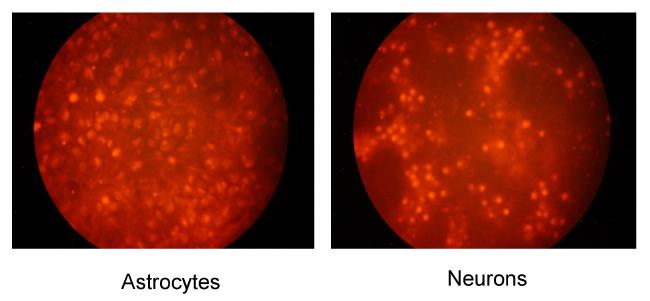
 DownLoad:
DownLoad: 